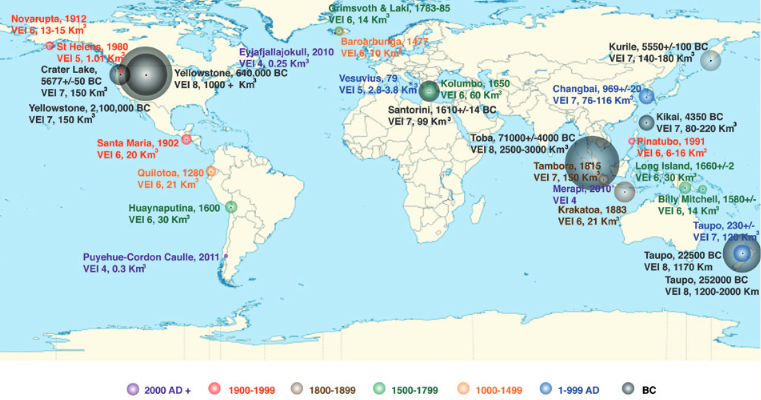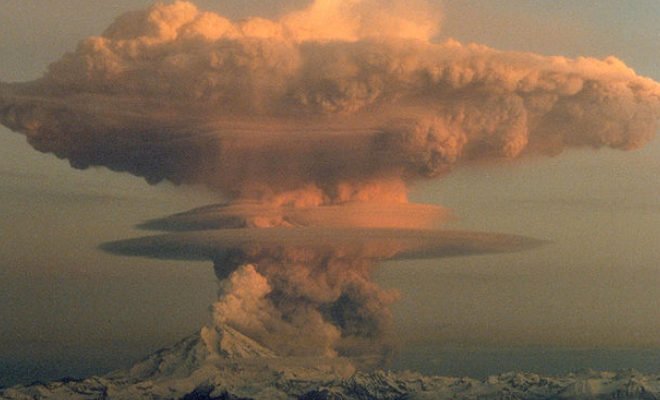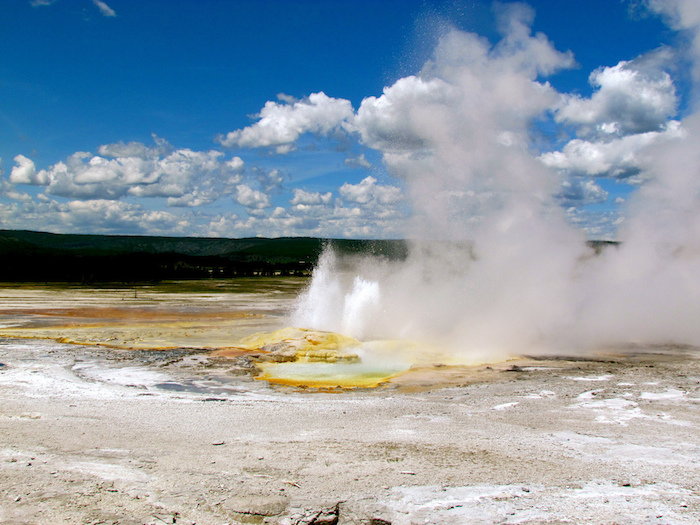A report presented by experts at a leading scientific foundation details the possibility of a supervolcano that could return humanity to pre-civilization state, urges global community to prepare.
Special Report
A report by the European Science Foundation has concluded that a large volcanic eruption poses the greatest risk to humanity and that an, "informed global governance system," is needed to prepare for the possibility.
Calling the threat of low-frequency, high impact events, "grossly underestimated," in disaster risk reduction plans worldwide, the report highlights the fact that, "large volcanic eruptions have the potential to impact climate, anthropogenic infrastructure and resource supplies on a global scale."
The 72 page report is chalked full of interesting facts and, overall, paints a picture of a world struggling to grasp the dangers posed by these rarely occurring disasters. Although the report should be read in full by anyone seeking the whole picture, the authors did incorporate a section with their key findings.
They include:
Extreme geohazards have the potential to generate global disasters.Presented in Vienna to the European Geosciences Union, the report explores other natural disasters such as earthquakes and floods but concludes that a large volcanic eruption poses the most extreme threat to the world with a 5-10% chance of happening within the century.
Recent large earthquakes have illustrated the extent of the destruction that extreme geohazards can inflict on a modern society, particularly through cascading effects and chains of failure.
Disaster risk reduction (DRR) focuses on the risk associated with relatively frequent hazards with major impacts, while the risk associated with low-probability, high-impact events is not sufficiently considered.
Threats from low-frequency, high-impact events are grossly underestimated in DRR.
This is particularly true for volcanic eruptions. So far, modern civilisation has not been exposed to an eruption comparable to the most extreme events that occurred during the Holocene.
Under today's circumstances, these events are associated with extreme disaster risks, comparable to other possible mega-disasters from extreme droughts, floods, pandemics and asteroid impacts.
A global volcano-monitoring system is required as a basis for an early warning system to provide timely warnings to mitigate impacts on transportation and food security.
Among geohazards (volcanic eruptions, earthquakes, tsunamis, landslides, floods, droughts, and bolides), large volcanic eruptions pose the most severe threat.
[...]
Under the present conditions of a globally connected civilisation facing food, water and energy scarcity, the largest eruptions during the Holocene would have had major global consequences.
Events on the scale of the Toba eruption 74,000 years ago could return humanity to a pre-civilisation state. Volcanic eruptions can have more severe impacts through atmospheric and climate eff ects and can lead to drastic problems in food and water security, as emphasised by the widespread famine and diseases that were rampant aft er the Laki 1783 and Tambora 1815 eruptions.
Hence extreme volcanic eruptions pose a higher associated risk than all other natural hazards with similar recurrence periods, including asteroid impacts. (emphasis mine)
During the Holocene, at least seven VEI 7 eruptions took place [VEI: Volcanic Explosivity Index]. All but one occurred at a time when the global population was far below 1 billion; with a population above 7 billion and heading for 12 billion, a recurrence of a VEI 7 eruption could have extreme consequences.
The probability of such an event occurring in the 21st century is 5 - 10%.Consequently, VEI 7 and larger eruptions represent a severe threat for our modern society.

Numerous actions that the scientists believe the world should take to prepare are listed in the report, including everything from money to global scientific frameworks and governance.Due to their far-reaching effects on climate, food security, transportation, and supply chains, these events have the potential to trigger global disaster and catastrophe.
The cost of response and the ability to respond to these events is beyond the financial and political capabilities of any individual country.
An international geopolitical response will be required, where science has a unique and key role in preparation, response and mitigation.
"Several elements are needed to reduce the global risk associated with extreme geohazards:"
Sadly, with a news media heavily focused on global conflict, internal political struggles, and celebrity worship preparing for or even talking about an extinction level event happens all too infrequently. The release of this report and coverage by the alternative media may change that.
- a global scientific framework for strategic extreme geohazards science in support of warnings, preparedness, mitigation and response to minimise the impacts of extreme geohazards
- scenario contingency planning to create the knowledge needed to reduce the risk by addressing systemic weaknesses that could lead to cascading effects
- increase of risk awareness through dissemination of information on the global risk associated with extreme geohazards
- a global monitoring system to provide early warning for emerging extreme volcanic eruptions
- an informed global governance system capable of responding to emerging global threats and coordinating measures to increase preparedness and general resilience with the goal of reducing the global disaster risk.
Yellowstone National Park - Supervolcano on the Brink?
Here in the United States most of the talk around volcanos surrounds Yellowstone National Park. The Yellowstone Caldera, located in northwest Wyoming, last erupted some 640,000 years ago. Signs of its awakening have significantly increased in the last 15 years.
The History Channels Mega Disasters provides background information:
Yellowstone National Park lies on top of a magma chamber that is 35-miles wide, waiting to erupt.
The Yellowstone Caldera is the volcanic caldera and supervolcano located in Yellowstone National Park in the United States, sometimes referred to as the Yellowstone Supervolcano. The caldera is located in the northwest corner of Wyoming, in which the vast majority of the park is contained. The major features of the caldera measure about 34 by 45 miles (55 by 72 km). The caldera formed during the last of three supereruptions over the past 2.1 million years. First came the Huckleberry Ridge eruption 2.1 million years ago, which created the Island Park Caldera and the Huckleberry Ridge Tuff. Next came the Mesa Falls eruption 1.3 million years ago, which created the Henry's Fork Caldera and the Mesa Falls Tuff. Finally came the Lava Creek eruption 640,000 years ago, which created the Yellowstone Caldera and the Lava Creek Tuff.
The last full-scale eruption of the Yellowstone Supervolcano, the Lava Creek eruption which happened nearly 640,000 years ago, ejected approximately 240 cubic miles (1,000 km3) of rock, dust and volcanic ash into the sky.
Geologists are closely monitoring the rise and fall of the Yellowstone Plateau, which measures on average 0.6 inches (1.5 cm) yearly, as an indication of changes in magma chamber pressure.
The upward movement of the Yellowstone caldera floor between 2004 and 2008 — almost 3 inches (7.6 cm) each year — was more than three times greater than ever observed since such measurements began in 1923. From mid-summer 2004 through mid-summer 2008, the land surface within the caldera moved upward as much as 8 inches (20 cm) at the White Lake GPS station. By the end of 2009, the uplift had slowed significantly and appeared to have stopped.
In January 2010, the USGS stated that "uplift of the Yellowstone Caldera has slowed significantly" and that uplift continues but at a slower pace. The U.S. Geological Survey, University of Utah and National Park Service scientists with the Yellowstone Volcano Observatory maintain that they "see no evidence that another such cataclysmic eruption will occur at Yellowstone in the foreseeable future. Recurrence intervals of these events are neither regular nor predictable."
This conclusion was reiterated in December 2013 in the aftermath of the publication of a study by University of Utah scientists finding that the "size of the magma body beneath Yellowstone is significantly larger than had been thought." The Yellowstone Volcano Observatory issued a statement on its website stating,
" Although fascinating, the new findings do not imply increased geologic hazards at Yellowstone, and certainly do not increase the chances of a 'supereruption' in the near future. Contrary to some media reports, Yellowstone is not 'overdue' for a supereruption. "
Other media reports were more hyperbolic in their coverage.
A study published in GSA Today identified three fault zones that future eruptions are most likely to be centered on. Two of those areas are associated with lava flows aged 174,000 - 70,000 years, and the third area is a focus of present-day seismicity.
In 2012 a study identified the fault lines within Yellowstone that were most likely to produce an eruption. This enabled officials to know which areas of the park to monitor more closely although other scientists noted that the patterns could change rather quickly. National Geographic reported:
A detailed April 2014 article by Michael Snyder about what an eruption of Yellowstone would actually look like included a startling list of known facts. Clearly most Americans have absolutely no idea how extremely horrific it would actually be.The natural beauty of Yellowstone National Park may appear serene, but it's rooted in a violent volcanic past. Now, geologists have identified which parts of the park are most likely to erupt again someday.
Yellowstone's next major eruption will probably be centered in one of three parallel fault zones running north-northwest across the park, a new study predicts.
Two of these areas produced large lava flows the last time the supervolcano was active—174,000 to 70,000 years ago—while the third has had the most frequent tremors in recent years.
#1 - A full-scale eruption of Yellowstone could be up to 1,000 time more powerful than the eruption of Mount St. Helens in 1980.Intellihub News Founder Shepard Ambellas has spent years detailing events around Yellowstone including rumors of censorship of data by the USGS and predictions by officials in early 2015 that it could blow anytime after the next, "two weeks." In fact, events in 2014 and early 2015 led many to believe the park was on the literal brink of eruption. Obviously that didn't happen but, regardless, all the facts that were exposed remain.
#2 - A full-scale eruption of Yellowstone would spew volcanic ash 25 miles up into the air.
#3 - The next eruption of Yellowstone seems to be getting closer with each passing year. Since 2004, some areas of Yellowstone National Park have risen by as much as 10 inches.
#4 - There are approximately 3,000 earthquakes in the Yellowstone area every single year.
#5 - In the event of a full-scale eruption of Yellowstone, virtually the entire northwest United States will be completely destroyed.
#6 - A massive eruption of Yellowstone would mean that just about everything within a 100 mile radius of Yellowstone would be immediately killed.
#7 - A full-scale eruption of Yellowstone could also potentially dump a layer of volcanic ash that is at least 10 feet deep up to 1,000 miles away.
#8 - A full-scale eruption of Yellowstone would cover virtually the entire midwest United States with volcanic ash. Food production in America would be almost totally wiped out.
#9 - The "volcanic winter" that a massive Yellowstone eruption would cause would radically cool the planet. Some scientists believe that global temperatures would decline by up to 20 degrees.
#10 - America would never be the same again after a massive Yellowstone eruption. Some scientists believe that a full eruption by Yellowstone would render two-thirds of the United States completely uninhabitable.
#11 - Scientists tell us that it is not a matter of "if" Yellowstone will erupt but rather "when" the next inevitable eruption will take place
In April 2014, a Pakistani publication claimed that the African National Congress had turned down a disaster management plan that would have housed American citizens in the event of a Yellowstone super volcano eruption. Shepard reported, "the African National Congress (ANC) recently turned down a $10B a year disaster management plan offered by the United States to house American citizens who may become displaced in the event that the Yellowstone supervolcano erupts.
The U.S. plan for relocation was formulated after a recent scientific analysis of the park revealed that Yellowstone's supervolcano has the potential to violently erupt within the next 10-years as noted by others including the famous astrophysicist Michio Kaku."
On January 29, 2015 Yellowstone Park geologist Hank Hessler was asked when he thought an eruption could happen and his answer showed how soon it actually could.
"Now what do we mean by foreseeable future? I would say, you know a couple of weeks, and that's what I would say with certainty."
In an article about Hessler's comments Shepard highlighted claims that the USGS was censoring data. "Although there is no way I can vouch for the information, according to a random individual who posted a video on YouTube, the USGS has likely been ordered by Washington to suppress information regarding recent seismic activity and gaseous releases in and around the Yellowstone region." Parts of the information in the video may provide hints going forward.
No one knows when Yellowstone or another major volcano in the world will actually erupt. Nonetheless, the fact remains that many leading scientists believe this is a major threat and that the worlds governments are not taking the threat serious enough.
"What would happen if America's dormant supervolcano erupted one day?"





Yes, governments are preparing. Preparing to save themselves, that is. If the people want help, they better learn to take care of their own needs.